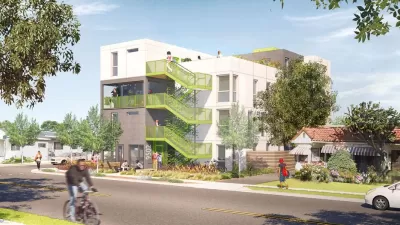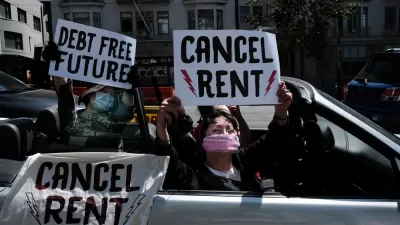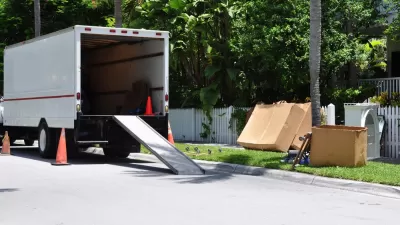Modular housing is cheaper and faster to build compared to conventional buildings. These advantages could make it an effective and viable way to increase apartment housing stock.

Matt Levin reports on developments in modular housing and its potential to bring down construction costs for larger buildings. A manufacturer in the San Francisco Bay Area assembles units offsite so the buildings can go up in days. "Picture one of those gigantic General Motors plants in Detroit, where a car is put together in an assembly line. Instead of a Buick and a conveyor belt, construction workers in hard hats and goggles are assembling a 156-unit apartment building for a development near Oakland," says Levin.
Levin also explores the history of pre-fab housing in the United States, including Operation Breakthrough, a federally funded $190 million initiative started in 1969 that eventually proved unsuccessful. "Much of the housing ended up being uninhabitable after a few years, adding to the public perception that factory-built housing was at best shabby, and at worst dangerous. Congress pulled the plug shortly after the prototype sites were completed."
Operation Breakthrough also could not achieve the necessary economies of scale, and today’s developers face the same challenge. With a focus on larger housing projects, rather than single-family homes, modular housing manufacturers hope that the market for mass-produced buildings will continue to grow.
FULL STORY: Can factory-built apartments solve California’s housing woes?

Planetizen Federal Action Tracker
A weekly monitor of how Trump’s orders and actions are impacting planners and planning in America.

The Simple Legislative Tool Transforming Vacant Downtowns
In California, Michigan and Georgia, an easy win is bringing dollars — and delight — back to city centers.

San Francisco's School District Spent $105M To Build Affordable Housing for Teachers — And That's Just the Beginning
SFUSD joins a growing list of school districts using their land holdings to address housing affordability challenges faced by their own employees.

In More Metros Than You’d Think, Suburbs are Now More Expensive Than the City
If you're moving to the burbs to save on square footage, data shows you should think again.

The States Losing Rural Delivery Rooms at an Alarming Pace
In some states, as few as 9% of rural hospitals still deliver babies. As a result, rising pre-term births, no adequate pre-term care and "harrowing" close calls are a growing reality.

The Small South Asian Republic Going all in on EVs
Thanks to one simple policy change less than five years ago, 65% of new cars in this Himalayan country are now electric.
Urban Design for Planners 1: Software Tools
This six-course series explores essential urban design concepts using open source software and equips planners with the tools they need to participate fully in the urban design process.
Planning for Universal Design
Learn the tools for implementing Universal Design in planning regulations.
Smith Gee Studio
City of Charlotte
City of Camden Redevelopment Agency
City of Astoria
Transportation Research & Education Center (TREC) at Portland State University
US High Speed Rail Association
City of Camden Redevelopment Agency
Municipality of Princeton (NJ)





























